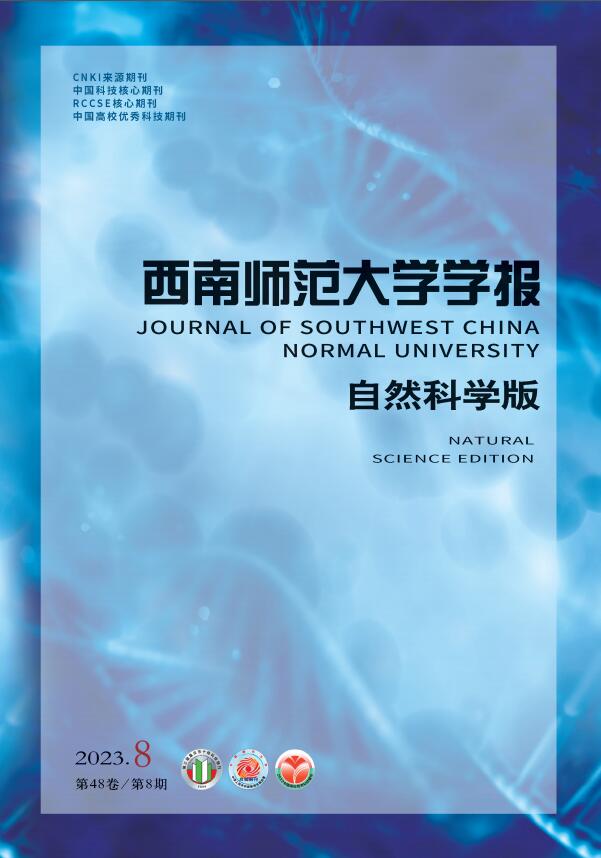-
本文研究Kirchhoff方程
其中V∈C(
$\mathbb{R}$ 3,$\mathbb{R}$ ),g∈C($\mathbb{R}$ ,$\mathbb{R}$ ),a和b是正常数.由于非局部项
$\int_{\mathbb{R}^3}|\nabla u|^2 \mathrm{~d} x$ 的存在,Kirchhoff问题被视为非局部问题. 关于这类方程的正解、多解和基态解的研究可参见文献[1-8]. 近年来,Kirchhoff方程的变号解受到广泛关注. 文献[9]在g(x,t)满足次临界条件的情形下,利用极大极小方法和下降流不变集得到了Kirchhoff方程的变号解. 文献[10]利用Nehari流形和变分法得到了带临界指数的Kirchhoff方程的基态变号解. 文献[11]在g(|x|,t) 满足4-超线性增长条件的情况下,得到了方程(1)仅变号k次的径向解. 文献[12]利用不变集和Ljusternik-Schnirelman型极大极小方法,得到了方程(1)的无穷多个变号解. 文献[13]在如下AR条件(G)成立时,得到了方程(1)的基态变号解:(G) 存在μ>2,使得tg(t)≥μG(t)>0对于所有t≠0成立,其中
$G(t)=\int_0^t g(s) \mathrm{d} s$ .我们把条件(G)减弱为以下条件:
(g1) 存在μ>2,使得tg(t)-μG(t)≥-υt2对于所有t≠0成立,其中υ>0充分小.
在本文中,假设V∈C(
$\mathbb{R}$ 3,$\mathbb{R}$ )和g∈C($\mathbb{R}$ ,$\mathbb{R}$ )分别满足如下条件:(V1)
$\inf\limits _{x \in \mathbb{R}^3} V(x)=V_0>0$ ;(V2) V(x)∈C(
$\mathbb{R}$ 3,$\mathbb{R}$ )是径向对称且可微的,$(\nabla V(x), x) \in L^{\infty}\left(\mathbb{R}^3\right) \cup L^{\frac{3}{2}}\left(\mathbb{R}^3\right)$ . 此外,存在μ>2,使得(g2) g∈C(
$\mathbb{R}$ ,$\mathbb{R}$ )并且$\lim\limits _{t \rightarrow 0} \frac{g(t)}{t}=0$ ;(g3)
$\lim\limits _{|t| \rightarrow \infty} \sup \frac{|g(t)|}{|t|^{p-1}}<\infty$ ,p∈(2,6).显然,条件(g1)比(G)弱. 本文利用文献[13]的思想,在上述条件(V1)-(V2)和(g1)-(g3)下,仍然得到了方程(1)的基态变号解.
记Hilbert空间
其内积定义为
其范数为
方程(1)对应的能量泛函为
方程的解与泛函的临界点一一对应. 本文用C,Ci表示各种正常数. 记S为最佳Sobolev常数:
本文的主要结果如下:
定理1 假设条件(V1)-(V2)和(g1)-(g3)成立,则方程(1)至少有一个径向对称的基态变号解.
由于4-超线性Ambrosetti-Rabinowtiz条件不成立,导致PS序列的有界性难以得到,所以需要引入一个扰动问题来克服这种困难. 设
$\alpha \in\left(0, \frac{\mu-2}{3 \mu+2}\right)$ ,固定λ,β∈(0,1],$r \in\left(\max \left\{p, \frac{9}{2}\right\}, 6\right)$ . 考虑如下扰动问题:其中
与之有关的能量泛函为
引理1 设u是Jλ,β在E中的临界点,(λ,β)∈(0,1]×(0,1],则
作为Lax-Milgram定理的应用,对于每一个u∈E,方程
都有唯一的弱解v∈E. 为了构造Jλ,β的下降流,引入一个辅助算子
其中v=Tλ,β(u)是方程(5)唯一的弱解. 由文献[13]可知,算子Tλ,β具有以下性质:
(ⅰ) Tλ,β是连续且紧的;
(ⅱ) ∀u∈E,J′λ,β(u-Tλ,β(u))≥‖u-Tλ,β(u)‖2;
(ⅲ) ∀u∈E,‖J′λ,β(u)‖2≤‖u-Tλ,β(u)‖(1+C1‖u‖2+C2‖u‖2α);
(ⅳ) (λ,β) ∈(0,1]×(0,1],c < d,τ>0,若Jλ,β(u)∈[c,d],‖J′λ,β(u)‖≥τ,则存在δ>0,使得‖u-Tλ,β(u)‖≥δ.
为了得到变号解,令
对于任意的ε>0,设
容易验证W是E中开的对称子集,并且E\W只包含变号解. 记
与文献[14]中引理2.4的证明类似,可以得到当ε∈(0,ε0)时,方程(3)的所有变号解都包含在E\W中.
引理2[15](形变引理) 设S⊂E,c∈
$\mathbb{R}$ ,ε,δ>0,满足其中
则对于0 < ε < ε1 < ε0,存在映射η∈C([0, 1]×E,E),使得:
(ⅰ) η(t,u)=u,当t=0或者u∉Jλ,β-1([c-2ε1,c+2ε1])时成立;
(ⅱ) η(1,Jλ,βc+ε∩S)⊂Jλ,βc-ε;
(ⅲ) ∀u∈E,Jλ,β(η(·,u))是非增的;
(ⅳ)
$\forall t \in[0, 1], \eta\left(t, \widetilde{P}_{\varepsilon}^{+}\right) \subset \widetilde{P}_{\varepsilon}^{+}, \eta\left(t, \widetilde{P}_{\varepsilon}^{-}\right) \subset \widetilde{P}_{\varepsilon}^{-}$ ;(ⅴ) ∀t∈[0, 1],若Jλ,β(·)是偶泛函,则映射η(t,·)是奇的.
定义1 [16] 如果下列形变性质成立:若Kc\W=
$\varnothing$ ,其中W=P∪Q,则存在ε0>0,使得η∈C(E,E)满足:(a)
$\eta(\widetilde{P}) \subset \widetilde{P}, \eta(\widetilde{Q}) \subset \widetilde{Q}$ ;(b) η|Ic-2ε=id;
(c) η(Ic+ε\W)⊂Ic-ε.
则{P,Q}是c水平集上关于I的可容许不变集族.
引理3 [16] 假设{P,Q}是c水平集上关于I的可容许不变集族,其中
$c \geqslant c^*=\inf\limits _{u \in \partial P \cap \partial Q} I(u)$ ,并且存在一个连续映射Ψ0:$\triangle \longmapsto E$ 满足:(ⅰ) Ψ0(∂1△)⊂P,Ψ0(∂2△)⊂Q;
(ⅱ) Ψ0(∂0△)∩M=
$\varnothing$ ,其中M=P∩Q;(ⅲ)
$\sup \limits _{u \in \varPsi_0\left(\partial_0 \triangle\right)} I(u)<c^*$ .其中
定义
$c=\inf\limits _{\varPsi \in \varGamma} \sup \limits _{u \in \varPsi(\Delta) \backslash W} I(u)$ ,其中则c≥c*,Kc\W≠
$\varnothing$ .定理1的证明
我们将利用引理3证明方程(3)存在变号解,再通过取极限得到方程(1)的基态变号解. 设P=Pε+,Q=Pε-,I=Jλ,β,S=E\W. 由引理2可知,{Pε+,Pε-}是泛函Jλ,β在c水平集上的可容许不变集族. 下面将分3步来完成定理1的证明.
步骤1 取v1,v2∈C0,r∞(B1(0)),使得supp(v1)∩supp(v2)=
$\varnothing$ ,其中v1 < 0,v2>0,Br(0)={x∈$\mathbb{R}$ 3:|x| < r}. 当(t,s)∈△时,设显然
由文献[13]的引理3.10可知,对任意的u∈∂Pε+∩∂Pε-,
$J_{\lambda, \beta}(u) \geqslant \frac{\varepsilon^2}{4}$ . 因此,$c^*=\inf\limits _{u \in \partial P_{\varepsilon}^{+} \cap \partial P_{\varepsilon}^{-}} J_{\lambda, \beta}(u) \geqslant \frac{\varepsilon^2}{4}$ . 设ut=φ0(t,1-t),t∈[0, 1]. 我们有当u∈φ0(∂0△)时,‖ut‖22≥
$\ell$ R. 对任意固定的u∈M=Pε+ ∩Pε-,所以,存在m>0,使得‖u‖q≤ mε. 因此,φ0(∂0△)∩Pε+ ∩Pε-=
$\varnothing$ . 通过直接计算可以得到由条件(g3)可知,对于任意的t∈
$\mathbb{R}$ ,存在正常数C3,C4,使得G(t)≥-C3|t|p-C4. 结合(1)式、(4)式和(6)式可以得到因为
$r \in\left(\max \left\{p, \frac{9}{2}\right\}, 6\right)$ ,所以当R趋于正无穷时,Jλ,β(ut)趋于负无穷. 因此,存在充分大的R使得根据以上分析可知,Jλ,β满足引理3的条件,所以
$c_{\lambda, \beta}=\inf\limits _{\varphi \in \varGamma} \sup \limits _{u \in \varphi(\Delta) \backslash W} J_{\lambda, \beta}(u)$ 是Jλ,β的临界值,cλ,β≥c*. 因此,存在uλ,β∈E\(Pε+ ∪Pε-),使得Jλ,β(uλ,β)=cλ,β,J′λ,β(uλ,β)=0.步骤2 取λ和β趋于0. 根据cλ,β的定义,对于任意的(λ,β)∈(0,1]×(0,1],有
不失一般性,假设λ=β. 取序列{λn}⊂(0,1]满足λn趋于0+,则存在Jλn,βn的临界点序列{uλn}(仍记为{un})使得Jλn,βn(un)=cλn,βn. 下面要证{un}在E中有界. 由Jλ,β的定义可以得到
此外,由引理1可得
用4,
$-\frac{1}{\mu}$ ,-1分别乘(8)式、(9)式、(10)式,最后相加得到因为
$\alpha<\frac{\mu-2}{3 \mu+2}$ 并且μ>2,结合条件(V2)和(7)式可得又由条件(g1)可知
利用Sobolev连续嵌入,
因此,当υ>0充分小时,
则存在正常数C5,使得
此外,结合(2)式、(7)式和(8)式以及假设条件(V1),(g2),(g3),可以得到:对任意的ε>0,存在Cε>0,使得
由插值不等式、Sobolev不等式和Young不等式,可以推出对任意的ε>0,存在
$\widetilde{C}_{\varepsilon}>0$ ,使得结合(11)式、(12)式和(13)式,可知{un}在E中有界. 又因为
并且,对于任意的Ψ∈C0∞(
$\mathbb{R}$ 3),所以,{un}是J在c*水平集上的有界PS序列. 因此,存在u*∈E,使得{un}在E中弱收敛到u*,{un}在Lq(
$\mathbb{R}$ 3)中强收敛到u*,q∈(2,6).因为{un}在E中有界,所以
由条件(g2),(g3)可得:对任意的ε>0,存在Cε>0,使得|g(t)|≤ε|t|+Cε|t|p-1. 结合Hölder不等式,有
因此
由〈J′(un)-J′(u*),un-u*〉0可知,{un}在E中强收敛到u*,此外,J′(u*)=0. 所以由un∈E\(Pε+ ∪Pε-)可以得到u*∈E\(Pε+ ∪Pε-),因此,u*是方程(1)的变号解.
步骤3 定义
根据步骤2的证明过程可知Θ≠
$\varnothing$ ,c≤ c*. 由c的定义,存在序列{un}∈Θ,使得J(un)→c,J′(un)=0,un±≢0. 根据步骤2的讨论,Jλ,β在cλ,β水平集上的有界PS序列也是J在c*水平集上的有界PS序列,所以,{un}在E中有界,并且由上一步的结论可知,{un}在E中强收敛到u,所以J(u)=c,J′(u)=0. 此外,由〈J′(un),un±〉=0可推断出:对于任意的0 < ε < 1,存在Cε>0,使得根据Sobolev不等式,有
由{un}在E中有界并且p>2可知,
$\int_{\mathbb{R}^3}\left|u_n^{\pm}\right|^p \mathrm{~d} x \geqslant C$ ,所以$\int_{\mathbb{R}^3}\left|u^{\pm}\right|^p \mathrm{~d} x \geqslant C$ . 因此u±≢0. 由以上分析可知u∈Θ并且$J(u)=\inf\limits _{v \in \varTheta} J(v)$ ,即J(u)≤J(v)(∀v∈Θ). 因此,u是方程(1)的基态变号解. 定理1的证明完成.
Existence of Ground State Sign-changing Solutions for a Class of Generalized Kirchhoff Equations
- Received Date: 27/05/2022
- Available Online: 20/01/2023
-
Key words:
- Kirchhoff equation /
- variational solution /
- nonlocal perturbation method /
- descending flow invariant set
Abstract: Study a class of generalized Kirchhoff equations $ -\left(a+b \int_{\mathbb{R}^3}|\nabla u|^2 \mathrm{~d} x\right) \triangle u+V(x) u=g(u) $ where \lt i \gt a \lt /i \gt , \lt i \gt b \lt /i \gt \gt 0 are constants. Since there are nonlocal terms \lt inline-formula \gt $ b\left(\int_{\mathbb{R}^3}|\nabla u|^2 \mathrm{~d} x\right) \triangle u$ \lt /inline-formula \gt in the equation, the variational generalization of the equation has different properties from the case \lt i \gt b \lt /i \gt =0. In contrast to the related literature, \lt i \gt g \lt /i \gt does not need to satisfy the monotonicity condition and the nonlinear term \lt i \gt g \lt /i \gt contains \lt i \gt g \lt /i \gt ( \lt i \gt t \lt /i \gt )=| \lt i \gt t \lt /i \gt | \lt sup \gt \lt i \gt p \lt /i \gt -2 \lt /sup \gt \lt i \gt t \lt /i \gt (2 \lt \lt i \gt p \lt /i \gt ≤4) this case, \lt i \gt V \lt /i \gt also does not need to satisfy the mandatory condition. Firstly, an auxiliary operator is introduced to construct a pseudo-gradient vector field to prove the existence of a descending flow invariant set. Second, since the 4-hyperlinear AR condition does not hold, it is necessary to introduce a nonlocal perturbation method by adding a higher-order term \lt i \gt β \lt /i \gt | \lt i \gt u \lt /i \gt | \lt sup \gt \lt i \gt r \lt /i \gt -2 \lt /sup \gt \lt i \gt u \lt /i \gt and another nonlocal perturbation. For the perturbed problem, the variational solution of the perturbed problem is obtained by the improved AR condition and the extremely minimal parameter under the descending flow invariant set, which in turn leads to the variational solution of the original problem. Finally, it is proved that the variational solution is the base-state variational solution of the original problem.






 DownLoad:
DownLoad: